The Google Pixel 10 Pro XL, part of the Pixel 10 series, shows that brains beat brawn every time. Google has once again nailed the AI phone market.
While Apple struggles with any Sirious AI and Samsung does Google’s promo work for it, Google once again understands the popular appeal of its smarter phones.
Now for a dose of reality. It has had a 105% year-over-year US growth in H1 2025, with 8% overall market share there. And that is just its Pixel 9 series. It is too early to report on the Pixel 10 impact, but it’s expected to double market share as buyers see it as a viable alternative to the Samsung Galaxy S25 series and grow tired of Apple’s lack of innovation.
By comparison, Samsung had a 7% y-o-y (mainly from its lower-cost A-series) and Apple 3% (from its older models).
After its August launch, it took 8.33% away from Apple’s market share with a massive spike in Google Chrome (Gemini AI) and a very deep dive in Apple Safari.
In Australia, Google Pixel 10 saw its market share increase from 8.8% to 22.53% at launch. People love this phone.
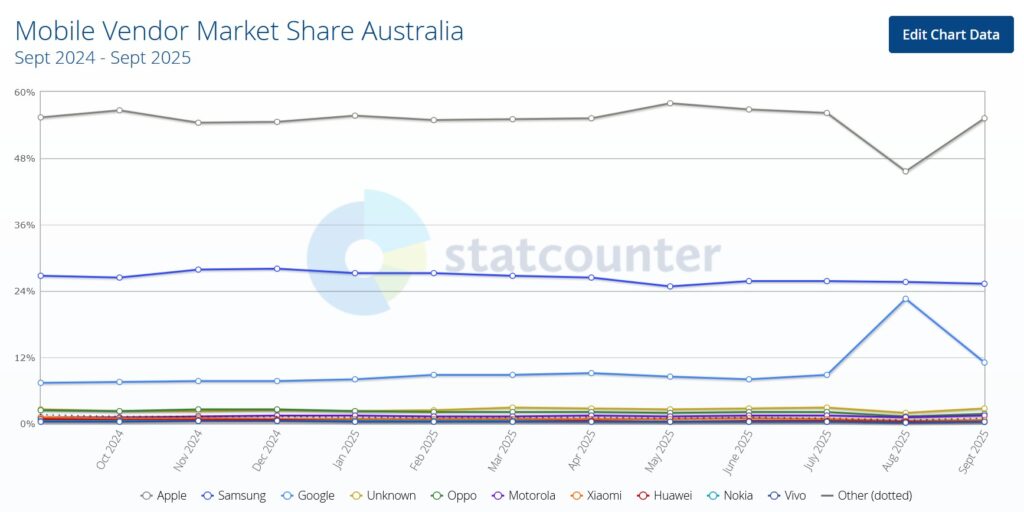
Now I understand why Google has, for at least the 8 and 9 series, said to reviewers, “Forget speeds and feeds. We are making an AI home that exceeds normal users’ needs”.
We won’t be covering AI features
This is a speeds and feeds review. You can read more about Google Gemini 2025.
- https://blog.google/products/pixel/google-pixel-10-ai-features-updates/
- https://store.google.com/intl/en_au/ideas/categories/ai/
- https://store.google.com/au/category/phones?hl=en-GB
What we will say is that this phone is all about AI and having the hardware necessary to support it. It never stuttered or failed; it was responsive and quick.
Australian Deep-dive Review: Google Pixel 10 Pro XL, SIM and eSIM, 16/256GB
| Brand | |
| Model | Pixel 10 Pro XL |
| Model Number | GA10424-CA-N |
| RAM/Storage Base | 16/256GB |
| Price base | $1999 256GB $2199 512GB $2549 1TB |
| Warranty months | 24-months |
| Teir | Premium |
| Website | Product Page |
| Manual | |
| From | Google Online, Harvey Norman, JB HI-Fi, Office Works. Telcos offer monthly phone repayment and mobile data plans: Optus, Telstra, Vodafone. |
| Country of Origin | China |
| Company | Google is a giant company that started with a search engine. It is now one of the largest advertising platforms in the world. It is behind the Android and Chrome operating systems. Beginning with the Pixel 8, Google has made AI-enhanced phones with its Google Gemini Nano, cloud and DeepMind technology used by Samsung and others. |
| More | CyberShack Google news and reviews |
| Test date | CyberShacks waits for at least one firmware upgrade. |
| Ambient temp | 16-30° |
| Release | Late August. |
| Other models not for Australia (Don’t buy) | Warranty is only valid with genuine Australian stock. Wi-Fi 6E/7 requires Australian firmware for its bands. A genuine phone has the R-NZ C-Tick About Phone>Regulatory Labels and the AU warranty under About>Phone>Limited Warranty. |
Ratings
We use the following ratings for many of the items below. CyberShack regards a score between 70 and 80/100 as a fit-for-purpose pass mark. You can click on most images to enlarge them.
- Fail (below expectations), and we will let you know if this affects its use.
- Pass(able) rating that is not as good as it should be.
- Pass (meets expectations).
- Pass ‘+’ rating to show it is good, but does not quite make it to Exceed
- Exceed (surpasses expectations or is the class leader).
How to make the best use of this deep dive review
We tested over 70 different aspects and uncovered nearly 300 key data points about the device. Overall reviews can reach a few thousand words. So, if you are keen, this is the world’s most comprehensive review!
If you want to see our impressions only, they are listed at the beginning of each table. At the end, you will find CyberShack’s view, competitor analysis, and ratings. Ratings are based on the price bracket and expectations, so a $200 phone may score as well as a $2000 phone—we compare like with like.
First Impression – it’s a 9!
No really. Apart from the SIM holder on the top (9 was on the bottom), it’s identical. Under the bonnet, the Tensor G4 (based on the 4nm Samsung Exynos 2400) has become a Tensor G5 based on a 3nm TSMC MediaTek Dimensity.
This move from Samsung allows it more creative design freedom, which we desperately hope it uses for the Pixel 11!
The PowerVR DXT-48-1536 GPU (was ARM Mali) is a fair bit slower, so don’t expect the 10 to play games like the 9. It uses the same Samsung Exynos 5400 modem and performs identically to the 9–city and suburbs only.
It has also swapped 8-bit/16.7m colour OLED screens from Samsung to BEO for marginally better brightness, but has yet to put on the big boys’ pants 10-bit/1.07 billion colour screens.
Screen: Pass but fail for PWM sensitive people
The 8-bit screen is always a bone of contention for me, as it is also on Samsung and iPhone.
First, the photo/video preview of colours is off – what you see on-screen is not what you get. Google has improved this slightly.
Second, a premium phone should also support Dolby Vision – 8-bit does not. Read 8-bit versus 10-bit screen colours. What is the big deal?
Third, is Pulse Width Modulation (OLED screens dim using a strobing on/off effect). The 120/240Hz repeating cycle can cause discomfort, eye strain, and nausea for PWM-sensitive people. OPPO and Motorola have raised the PWM frequency beyond the human threshold, and it doesn’t affect PWM-sensitive people. We don’t deduct points for PWM but reward those who address it. Read PWM – Is your phone making you sick?.
For all non-PWM sufferers, this is a bright, daylight-readable AMOLED screen. The Pixel 10 has a warmer colour than the cooler, whiter Pixel 9, but you get used to it.
Note that you will likely use this screen in 1080p mode to save battery.
| Size | 6.8″ Pro XL 6.3″ Pro |
| Type | LTPO OLED Model GGL BMEA-AOD-00 |
| Flat, Curve, 2D, 3D | Flat with centre O-hole |
| Resolution | Pro XL 2992 x 1344 (defaults to 2404 x 1080) Pro 2856 x 1280 (defaults to 2244x 1080 |
| PPI | Pro XL 486 Pro 495 |
| Ratio | 20:9 |
| Screen to Body % | 88% |
| Colours bits | 8-bit/16.7m colours Google calls this 24-bit (3 x 8-bit RGB) |
| Refresh Hz, adaptive | 1-120Hz |
| Response 120Hz | N/A |
| Nits typical, test | Not disclosed. Test 100% window 1250 nits. |
| Nits max, test | 2200 HBM (Test 1999 in 5% window) 3000 Peak (2674 in 5% Window) |
| Contrast | Infinite 2,000,000:1 |
| sRGB | It has Natural or Adaptive (saturated) settings. 99% coverage |
| DCI-P3 | Not disclosed (Adaptive setting – Test 86% of 16.7m colour gamut) |
| Rec 2020 or other | N/A: Note that there are no calibration settings. |
| Delta E (<4 is excellent) | <1 |
| HDR Level | HDR10/HLG/HDR10+ (No Dolby Vision) |
| SDR Upscale | No |
| Blue Light control | No |
| PWM if known | 120 Hz <50% brightness 240 Hz >50% Brightness A 240 Hz cycle is very low and will affect PWM-sensitive users. |
| Daylight readable | Yes |
| Always on Display | Yes |
| Edge display | No |
| Accessibility | All Android features and hearing aid-compatible per FCC requirements. Guided Frame Magnifier Live Caption Live Transcribe and Sound Notifications TalkBack screen reader, including image descriptions with Gemini Lookout Reading Mode Sound Amplifier and Conversation mode Camera Switches Voice Access Real-time text |
| DRM | L1 for FHD, SDR and HDR10+ (limited availablbility) |
| Gaming | <2ms GTG |
| Screen protection | Gorilla Glass Victus 2, Mohs level 6 |
| Comment | This is an 8-bit/16.7m colour screen, while flagships have 10-bit/1.07 billion colour screens (except for Samsung). It is now a BOE GGL-BMEA-A0D-00 panel (was Samsung AMOLED) We can see the difference between the photo and video image preview and the end result. The screen does not support Dolby Vision (it should). PWM is among the most severe we have seen, and sensitive users will need to look elsewhere. |





Processor: Pass
I am giving this a PASS out of sheer frustration in having to run extensive, long and arduous tests at least three times – pre-release firmware, September, and October updates and getting rubbish results as Google locks the phone out of much benchmarking software.
And I can’t be sure of the results when the next round of firmware updates come. I ran the tests side-by-side with the Pixel 9 Pro XL to ensure fairness (in brackets).
I will repeat my comment about moving from Samsung Exynos, and it’s a shame they did not use the MediaTek modem, which is showing considerable improvement over the Exynos modem. Google is out of Samsung’s shadow and now has 100% creative and design freedom, and I hope it uses that.
| Type | Google Tensor G5 |
| nm | 3nm TSMC (no longer a rebadged Samsung Exynos) |
| Cores | 1 x 3.78 GHz & 5 x 3.05 GHz & 2 x 2.25 GHz |
| GPU | PowerVR DXT-48-1536; 1100 MHz 1689.6 GFLOPS Ray tracing is not supported. |
| Modem | Samsung Exynos 5400i |
AI – Pass
All we know is that it is a ‘next generation’ NPU, and we think the results are correct. This is a faster CPU, but the AI results don’t generally match the Pixel 9. In particular, AITuTu and AnTuTu are very much slower.
| AI TOPS OR Multi-thread Integer Operations Per Second (INOPS) GINOPS = billion | Geekbench AI 6.5.0 (Tensor G4 updated to Android 16 in brackets) CPU: 1918/1952/3017 (1671) GPU: Would not run (1304) NNAPI: 346/783/3890 (8941) AiTuTu V3.5.8: 66,697 (104426) AI Benchmark: 800 (1168) GFLOPS: 22.35 (14.43) GINOPS: 28.90 (19.34) |
| Antutu | 994,836, (1,420,349) |
| Geekbench 6 Single-core | 2318 (1973) |
| Geekbench 6 multi-core | 6293 (4713) |
| Like | We had significant variances between the pre-release firmware, the September and the October updates. We have restested these several times side-by-side with the Google Pixel 9 Pro XL. Geekbench is 6.5, AiTuTu and AnTuTu are the latest versions. |
Other SoC tests – Pass
If the OpenCL and Vulcan tests are correct (we think they are), the GPU has about 30% of the capacity of the Pixel 9.
| OpenCL | 3196 (8408) |
| Like | |
| Vulcan | 3690 (9523) |
| RAM, type | 16GB LPDR5 with 3GB reserved for AI |
| Storage, free, type | 256GB UFS 4.0 (200GB free) |
| micro-SD | No |
| CPDT internal seq. Read MBps sustained/peak | 1060 (2.73 max) |
| CPDT internal seq. write MBps sustained/peak | 904.85 (1.25 max) |
| CPDT microSD read, write MBps | N/A |
| CPDT external (mountable?) MBps | Files finds it as an OTG for cut and paste, but not as a mountable device, and will not speed test. |
| Comment | Benchmarks |
Throttle – Fail
It is a hot chip, and while it has raw performance advantages over the Pixel 9, it’s as bad for throttling.
| Throttle test | Charge |
| Max GIPS | 368,198 (332,671) |
| Average GIPS | 266,575 (224,885) |
| Minimum GIPS | 209,872 (195,610) |
| % Throttle | 38 |
| CPU Temp | 50 |
| Comment | We repeated the throttle test several times, and the results are consistent – 34-40% under load. This is not a gamer’s CPU. |

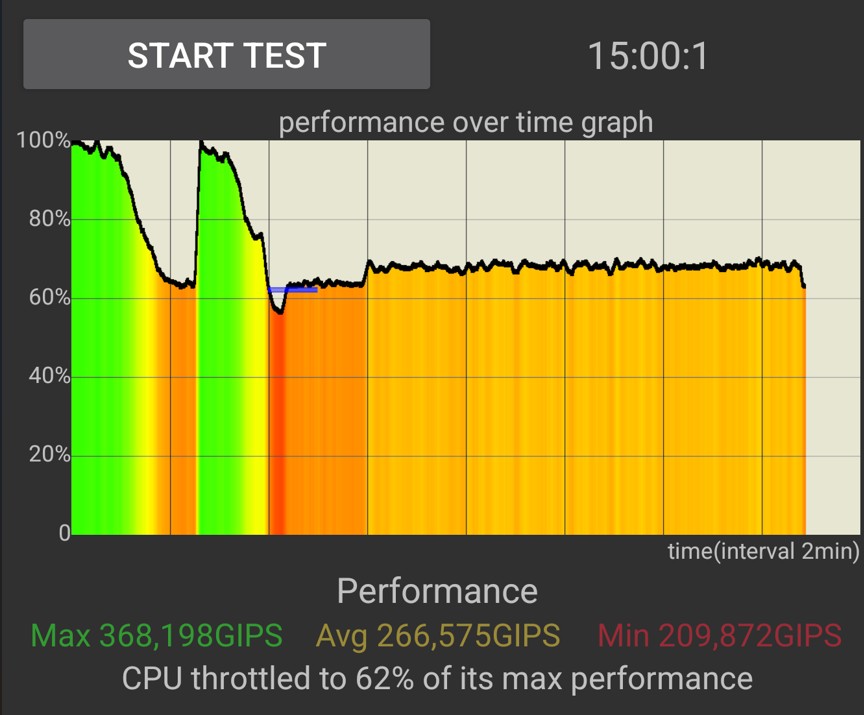
Comms – Pass+
We use the TP-Link Deco BE85 Wi-Fi 7 BE22000 tri-band mesh router – If you feel the need for massive, distributed speed.
It is comparable to the Pixel 9. It does not support MLO band aggregation and maxes out at 2500 Mbps (versus over 5000 for phones supporting MLO). Rx and Tx speeds are variable and are not rock solid. This is another disappointing Samsung Exynos Modem issue.
| Wi-Fi Type, model | Wi-Fi 7 BE Tri-band 2.4/5/6Ghz 2 x 2 MIMO Thread networking NB-IoT |
| Test 2m -dBm, Rx/Tx Mbps | -48/1218 to 2450/1724 to 2482 |
| Test 5m | -54/1306 to 2082/1814 to 2313 |
| Test 10m | -61/1388 to 1790/1633 to 2269 |
| BT Type | 6 |
| GPS single, dual | Dual-Band GNSS GPS, GLONASS, Galileo, Beidou, QZSS, NavIC |
| USB type | USB-C 3.2 Gen 2 10Mbps |
| ALT DP, DeX, Ready For | Supports Alt DP audio/video. Does not support mountable external SSD (OTG only) |
| NFC | Yes |
| Ultra-wideband | Yes |
| Sensors | |
| Accelerometer | Yes |
| Gyro | Yes |
| e-Compass | Yes |
| Barometer | Yes |
| Gravity | |
| Pedometer | |
| Ambient light | |
| Hall sensor | Yes |
| Proximity | Yes |
| Other | Thermometer |
| Comment | It has a USB-C 3.2 Gen 2 10Gbps interface and now allows Alt DP 1.4 screen mirror. It does not allow a mountable external SSD, which is a real issue for vloggers and videographers. |



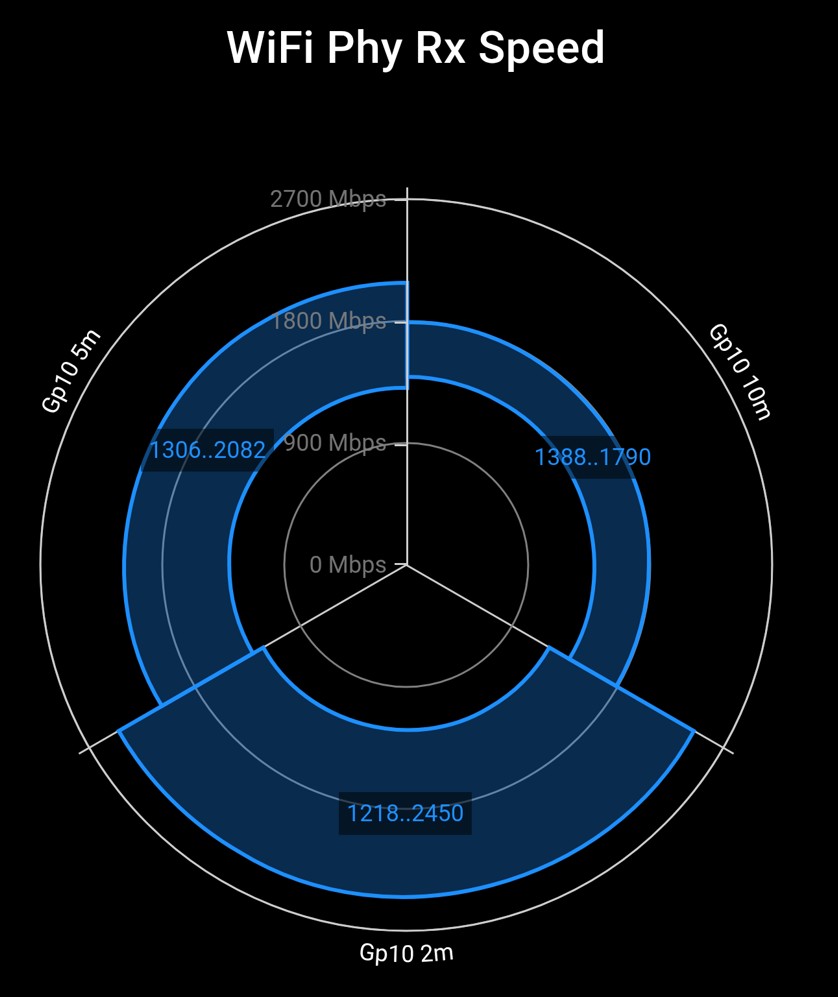
4/5G – City and Suburbs only
Despite Telstra crowing that the Pixel 10 Pro and Pro XL are Blue Tick certified for rural and remote use, they are not capable of more than city and suburbs. Read Telstra Blue Tick Part V: More bloody lies from the expert.
It’s also disappointing that the two SIMs (physical and eSIM) are only DSDS (only one active at a time), where DSDA (both active) is becoming more common—another Samsung Exynos modem issue.
| SIM | Single SIM and eSIM |
| Active | DSDS (Dual SIM, Dual Standby) only one active at a time. |
| Ringtone | Single |
| VoLTE | Yes |
| Wi-Fi calling | Yes |
| 4G Bands | 1/2/3/4/5/7/8/12/13/14/17/18/19/20/21/25/26/28/29/30/32/38/39/40/41/42/48/66/71/75 |
| Comment | All Australian and international bands |
| 5G sub-6Ghz | 1/2/3/5/7/8/12/14/20/25/26/28/30/38/40/41/66/71/75/76/77/78/79 |
| Comment | All sub-6GHGz bands |
| mmWave | No |
| Test Boost Mobile, Telstra | |
| DL/UL, ms | 38.8/22.2/38ms (average but long lag) |
| Tower 1 -dBm, fW or pW | From -81 to -94 and 398.1 to 7.9 Pw Picked up a 5G signal, but unusable. |
| Tower 2 | No |
| Tower 3 | No |
| Tower 4 | No |
| Indoor | No usable indoor coverage |
| Comment | Strictly a city and suburbs phone where there is good tower coverage. |


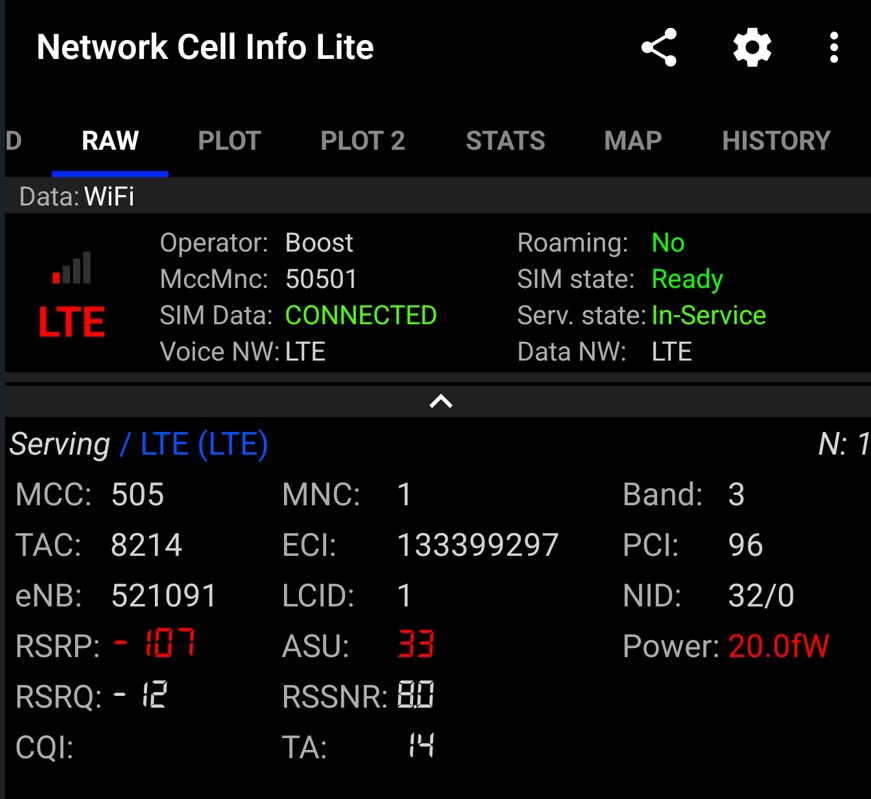
Battery – Pass
It only earns a pass as there is no way we could get it to last 24 hours as claimed by Google. No charger is supplied, and the $49.99 Google 45W charger is one of the few PPS chargers that can deliver 21V/2.25A/45W. Most PPS chargers will max out at 9V/3A/27W.
It is a daily charge for typical users and 8 hours for heavy users. Google has implemented Battery Health Assistance that will manage the charge capacity of the battery and reduce it over time.
| mAh | 5200mAh Model GD1J6 3.89V/5.2A/20.23W No indication of full recharge cycles – assume 500 (it is not more) |
| Charger, type, supplied | Not supplied 45W PPS 3.0 capable (20V/2.25A/45W). Most PD chargers will charge at 9V/3A/27W. |
| PD, QC level | PPS 3.0 |
| Qi, wattage | Qi2 magnetic charging up to 25W |
| Reverse Qi or cable. | No Wireless – cable 5W. |
| Test (60Hz or adaptive screen) | Adaptive |
| Charge % 30mins | Claim: 70% in about 30 minutes Test: 55% @27W |
| Charge 0-100% | 1 hour 22 minutes @27W |
| Charge Qi, W | Up to 25W Qi2 Magnetic ring (not tested) |
| Charge 5V, 2A | N/A |
| Video loop 50%, aeroplane mode | 17 hours 38 minutes |
| PC Mark 3 battery | 14 hours Accubattery 17 hours |
| GFX Bench Manhattan battery | Hung – out of memory |
| GFX Bench T-Rex | 451.2 minutes 7.52 hours 6728 frames (621.3 minutes/3360 frames) |
| Drain 100-0% full load screen on | 4 hours 35 minutes (5 hours 2 minutes) AccurBattery 4 hours 36 minutes |
| mA Full load screen on | 50% screen 1100-1150mA 100% screen 2250-2500mA |
| mA Watt idle Screen on | 200-250mA |
| Estimate loss at max refresh | Tested on Adaptive |
| Estimate typical use | Google advertises up to 24 hours of typical use. Heavy users (gamers) will get 5-6 hours of screen-on time. |
| Comment | Battery Health Assistance feature that gradually limits charging speed and capacity after 200 charge cycles, and cannot be turned off. This is designed to preserve long-term battery health, but it will result in slower charging and a shorter battery life over time. |
Sound hardware – Pass
Our analytics software cannot detect any ‘brand’ amps or DACs, so we assume that it’s part of the Tensor G5. Google does not process Dolby Atmos, but does have a spatial sound setting that seems to create faux 3D from 2.0. There is no EQ.
It has LDAC (for high definition), but the other codecs use standard 16-bit/44100Hz.
| Speakers | Forward-firing earpiece and bottom-firing speaker |
| Tuning | N/A |
| AMP | Appears to use SoC sound – no external amplifiers detected |
| Dolby Atmos decode | No, but as a spatial audio setting for speakers and headphones |
| Hi-Res | No 16-bit/44100/48000Hz |
| 3.5mm | No, and requires an external USB-C DAC to plug in headphones. |
| BT Codecs | SBC, AAC, royalty-free aptX and HD, LDAC |
| Multipoint | Yes |
| Dolby Atmos (DA) | No, but supports Spatial Audio on USB wired headphones. |
| EQ | No |
| Mics | Three, including one for noise reduction |
| Test dB – all on EQ flat DA off | |
| Volume max | 80 |
| Media (music) | 75 |
| Ring | 75 |
| Alarm | 72 |
| Notifications | 75 |
| Earpiece | 70 |
| Hands-free | A little low volume, but otherwise OK. |
| BT headphones | Excellent BT signal, but only supports a limited range of codecs. |
Sound quality – Passable
Music needs a mix of bass, mid and treble to sound good. No!
Clear voice needs a focus on 1-4kHz to make voice conversations clearer. Yes!

| Deep Bass 20-40Hz | Nil |
| Middle Bass 40-100Hz | Nil |
| High Bass 100-200Hz | Linear slow build to 1kHz – almost no high bass |
| Low Mid 200-400Hz | Almost nil – a long, slow build |
| Mid 400-1000Hz | still slow building |
| High-Mid 1-2kHz | Flatish |
| Low Treble 2-4kHz | Flattish |
| Mid Treble 4-6kHz | Linear decline to 7kHz |
| High Treble 6-10kHz | Flattish to 15kHz |
| Dog Whistle 10-20kHz | Steep linear decline to 20kHz |
| Sound Signature type | It is similar to the Pixel 9. It still has no low/mid-bass, some high bass, slowly building mids (no vibrancy), 1-4kHz for clear voice is fine, and some low/mid-treble gives it some crisp treble notes. |
| Soundstage | Better top/bottom speaker balance. The sound stage is as wide as the phone. It does not support Dolby Atmos. |
| Comment | If you like listening to audio or video on phone speakers, this is not for you. |
Build – Pass+
We mentioned the Foxconn build quality earlier and its top drawer. The repairability rating has improved markedly, with Jerry Rig declaring it the most repairable Pixel yet. We have teardown and durability videos below. All Pixel 10s share the same construction.
| Size (H X W x D) | 162.8 x 76.6 x 8.5 mm |
| Weight grams | 232 |
| Front glass | Gorilla Glass Victus 2 |
| Rear material | Gorilla Glass Victus 2 Mohs 6 |
| Frame | 100% recycled aluminium |
| IP rating | IP68 |
| Colours | Moonstone Jade Porcelain Obsidian |
| Pen, Stylus support | No |
| Teardown | Easy screen replacement Most repairable |
In the box – Fail
We always deduct points for no charger. At least Google supplies a 3W cable.
| In the box | |
| Charger | No |
| USB cable | 1m USB-C to USB-C 2.0 3W cable |
| Buds | No |
| Bumper cover | No |
Tear Down
Durability
OS – Exceed
Google Pixel is usually launched with the next version of Android, e.g., 16. Please ignore the Safety features – most are currently only for the USA.
We would typically discuss AI features, but we have covered these in other documents. To be fair, those interested in AI will have read all they can before deciding to purchase.
It is critical to note that this is pure Android, which makes upgrading and transitioning from other Android and iPhones easy—it works. Other bands using proprietary User interfaces, Google app substitutes and switching programs can make it hard to leave that brand.
| Android | 16 |
| Security patch date | 5 October 2025 |
| UI | Pure Android |
| OS upgrade policy | 7 years |
| Security patch policy | 7 years – monthly updates |
| Bloatware | Gemini Nano Gemini, your built-in AI assistant Gemini Live Gemini Apps Pixel Screenshots Magic Cue Circle to Search Live Translate Call Assist |
| Other | Safety – Many only US at present Satellite SOS (trial) Emergency SOS Crisis Alerts Car Crash Detection Safety Check Emergency Location Service Emergency Contacts & Medical Info Android Earthquake Alerts System Theft protection |
| Comment | Pure Android and the best upgrade policy, bar none. |
| Security | |
| Fingerprint sensor location, type | Ultrasonic under glass |
| Face ID | Secure Face unlock |
| Other | Tensor M2 Chip |
| Comment | VPN by Google One at no extra cost End-to-end security designed by Google Multi-layer hardware security: Tensor security core, Titan M2 security chip and Trusty (Trusted Execution Environment) Seven years of OS, security and Feature Drop updates from launch Anti-malware and anti-phishing protection, including support for passkeys Automatic security checks and privacy controls with Security and Privacy Hub Camera and mic toggles Private Compute Core Android System Intelligence Android Messages end-to-end encryption and Android backup encryption |
Google Pixel 10 Pro XL rear camera – It is officially the second best in Oz – Exceed
First, let me say that CyberShack tests the most common point-and-shoot modes that buyers are likely to use. The results are excellent, losing the top spot to the iPhone 17 Pro Max. It considerably exceeds the Samsung S25 Ultra, which is also pretty good in the first place.
At the end of the table below are links to DXOMARK testing.
But this is essentially the same three sensors as the Pixel 9 Pro XL.
- 50MP Samsung GNK wide (primary)
- 48MP Sony IMX858 Ultrawide/macro.
- 48MP Sony IMX858 sensor as a periscope telephoto lens.
Google’s secret sauce is that the AI can see these as up to six different sensors and focal lengths and selects the best for the shot.
Video is up to 8K at 30fps on the primary sensor and 4K@60 on the other sensors.
Test photos










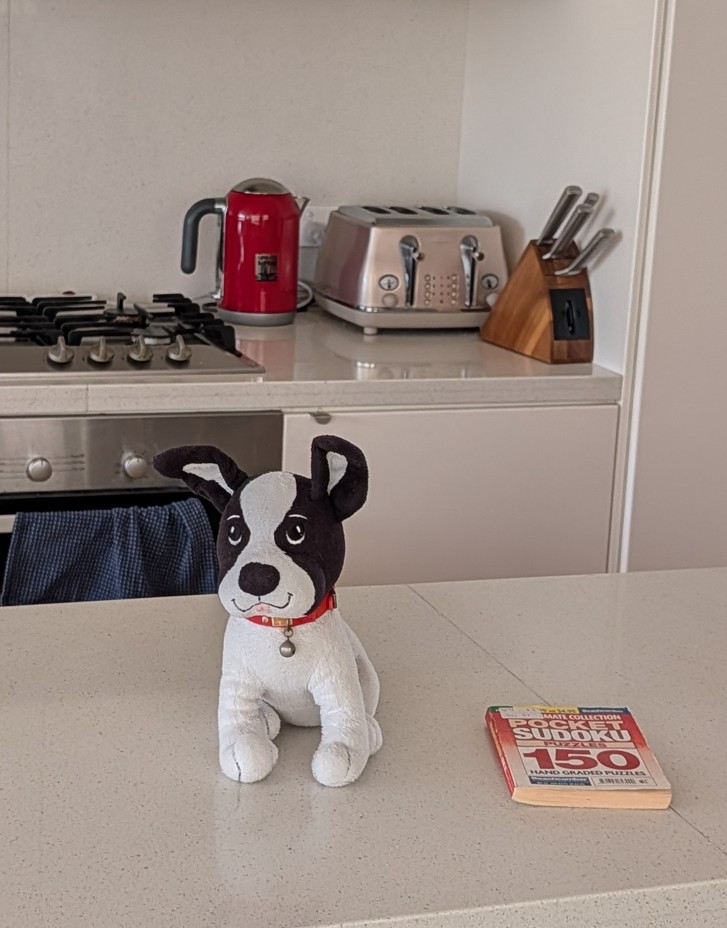



| Rear Primary | Wide |
| MP | 50MP bins to 12.5 |
| Sensor | Samsung GNK |
| Focus | Dual pixel PDAF Multi-zone laser AF |
| f-stop | 1.68 |
| um | 1.2 bins to 2.4 |
| FOV° (stated, actual) | 82 |
| Stabilisation | OIS |
| Zoom | 30x |
| Rear 2 | Ultrawide/macro |
| MP | 48MP bins to 12.2 |
| Sensor | Sony IMX858 |
| Focus | PDAF Dual Pixel |
| f-stop | 1.7 |
| um | .7 bins to 1.4 |
| FOV (stated, actual) | 123 |
| Stabilisation | No |
| Zoom | |
| Rear 3 | Periscope telephoto |
| MP | 48MP bins to 12.2 |
| Sensor | Sony IMX858 |
| Focus | PDAF Dual Pixel |
| f-stop | 2.8 |
| um | .7 bins to 1.4 |
| FOV (stated, actual) | 22 |
| Stabilisation | OIS |
| Zoom | 5X Optical and up to 100X Hybrid via AI LLM Model |
| Rear 4 | Time Of Flight sensor STM VL53L1 single point measures distance between 4-10m |
| Special | The analytical software sees six rear sensors (3 physical) with differences in zoom, crop factors and focal lengths. AI allows it to select the best virtual sensor for the job. |
| Video max | Varies with each virtual sensor from 8K@30 to 1080p@60 |
| Flash | dual LED |
| Auto-HDR | 10-bit HDR |
| Pro controls High-Res (up to 50 MP) Pro Res Zoom up to 100 Camera Coach Add Me Macro Focus Night Sight Astrophotography High-Res Portrait Mode (50 MP) Face Unblur Auto Unblur Long Exposure Action Pan Real Tone Panorama Auto Best Take Frequent Faces Top Shot Editing features Pixel Studio Auto Frame Reimagine Sky styles Resize and move subjects Portrait Blur Magic Eraser Best Take Photo Unblur Zoom Enhance Portrait Light | |
| QR code reader | Yes |
| Night mode | Auto |
| DXO Mark |
Google Pixel 10 Pro XL selfie
| Front | Selfie |
| MP | 42MP bins to 10.5MP/8.4 |
| Sensor | Sony IMX858 |
| Focus | PDAF |
| f-stop | 2.2 |
| um | .7 bins to 1.4 |
| FOV (stated, actual) | 83.2 to 94.9 |
| Stabilisation | No |
| Flash | Screen Fill |
| Zoom | No |
| Video max | 4K@60fps |
| Features | Video features Video Boost Night Sight Video Audio Magic Eraser Macro Focus Video 10-bit HDR video Cinematic Blur Cinematic Pan Slo-mo video support up to 240 FPS 4K timelapse with stabilisation Astrophotography timelapse Night Sight timelapse Optical image stabilisation for video Fused Video Stabilisation Cinematic Pan video stabilisation (4K, 1080p) Locked video stabilisation (4K, 1080p) Active video stabilisation (1080p) Video formats: HEVC (H.265), AVC (H.264), AV1, VP9 Audio Stereo recording Speech enhancement Wind noise reduction Audio zoom |
| Comment | DXO Mark test Apple iPhone 17 Pro 168 Google Pixel 10 Pro XL 165 Google Pixel 9 Pro XL 160 Apple iPhone 16 Pro 157 Samsung Galaxy S25 Ultra 151 |
CyberShack’s view: Google Pixel 10 Pro XL (and the rest of the 10 series) is seriously smart
Google does not like speed and feed reviews as it considers them irrelevant to an AI phone that either does what it claims, or not.
As an AI phone, it excels. Putting it side-by-side with the Samsung S25 Ultra, it works more fluidly and has way superior photo prowess.
As a piece of hardware, the Samsung S25 Ultra is superior in most areas, but then its cost allows it to be so.
Google listened to the market (probably literally) and the device and its marketing are spot on.
Google Pixel 10 Pro XL ratings
Our ratings are largely still on speeds and feeds.
| Features | 85 |
| Has everything you need, and a thermometer you will probably never use. | |
| Value | 80 |
| What price do you put on it? On a speed and feeds basis, there are many more powerful phones for a lot less. Ignoring that for its photography and AI potential, it is well priced against the comparable Samsung S25 Ultra. | |
| Performance | 75 |
| The Tensor G5 throttles badly. On a speeds and feeds basis, it is fairly well behind the Samsung S25U, but again, that is not this phone’s criteria. | |
| Ease of Use | 85 |
| Gemini gets better and better and has become more intuitive in this release. Google’s Pure Android is a boon compared to the increasingly messy Samsung UI 8 and the convoluted privacy terms. | |
| Design | 80 |
| I don’t mind Google styling – it is different in a sea of glass slabs. | |
| Rating out of 10 | 81 |
| Final comment | It is more of the same – Pixel 9 and 10 are twins. The new processor is more than fit for purpose (although not as strong as the Tensor G4 in some areas), and the phone works beautifully. |
CyberShack Verdict
The Google Pixel 10 Pro XL, part of the Pixel 10 series, shows that brains beat brawn every time. Google has once again nailed the AI phone market.
From $1999

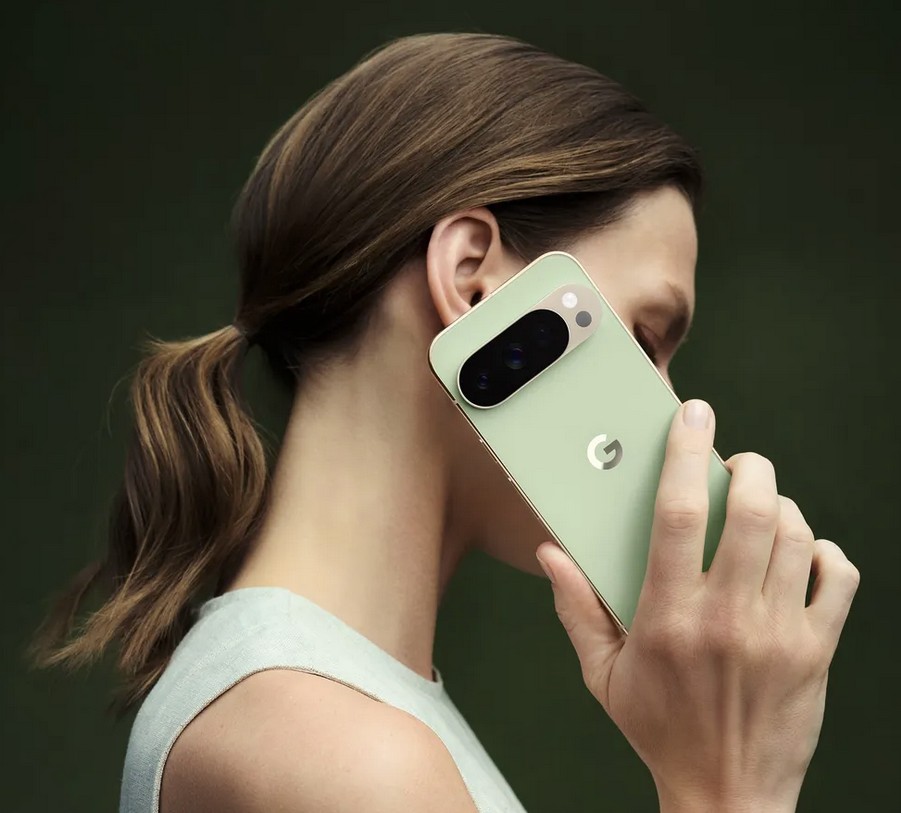









Comments